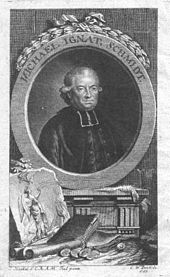Michael Ignaz Schmidt
Michael Ignaz Schmidt (born January 30, 1736 in Arnstein ; † November 1, 1794 in Vienna ) was a German Catholic priest, catechist , historian and archivist, who was best known to the Germans for his history .
Live and act
Michael Ignaz Schmidt was born as the son of an Episcopal Würzburg chief customs officer and forest accountant in Arnstein and had three brothers who were all clergy. One of them was the auxiliary bishop of Speyer, Philipp Anton Schmidt (1734-1805).
He attended the school in his hometown, then the grammar school and the University of Würzburg , where the Jesuits trained him. After that he entered the episcopal clerical seminary and became a priest. First Schmidt officiated as chaplain in Hassfurt , then as educator in the service of the Prince-Bishop of Bamberg, Count Johann Alexander von Rottenhan .
In 1769 he was called back to Würzburg , where he was rector of the Seminarium Nobilium (aristocratic seminar) and in 1771 university librarian. In 1773 he was appointed professor of German imperial history because of his historical interests.
Under Prince-Bishop Adam Friedrich von Seinsheim, Schmidt worked on the renewal of the school system in the Würzburg Monastery , and he was also involved in the establishment of a school teachers' seminar.
In 1778 the first two volumes of his "Geschichte der Teutschen" appeared, which comprised a total of eleven volumes and remained unfinished. Michael Ignaz Schmidt made this work known nationwide. Empress Maria Theresa noticed him and wanted to bring him to Vienna as a historian. That failed because Prince-Bishop Franz Ludwig von Erthal was not prepared to do without Schmidt in Würzburg. However, he could not prevent the clergyman from being invited to Vienna for study purposes, which ultimately led to his permanent move.
Schmidt was promoted to court counselor and in 1780 director of the house and state archives , with a respectable salary. In addition, he was able to devote himself to his historical studies unhindered and published further volumes of his “History of the Teutschen”. Emperor Joseph II also engaged him as a history teacher to his nephew and former successor Franz II.
Michael Ignaz Schmidt died on November 1st, 1794 in Vienna.
Afterlife
He became famous for his "History of the Germans" (from 1778). The state secondary school in Arnstein is named after him.
His bust was displayed in the Hall of Fame in Munich.
literature
- Peter Baumgart (Ed.): Michael Ignaz Schmidt (1736–1794) in his time. The enlightened theologian, educational reformer and “historian of the Germans” from Franconia in a new perspective. Contributions to a symposium from October 27 to 29, 1994 in Würzburg (= sources and contributions to the history of the University of Würzburg . Vol. 9). Degener, Neustadt an der Aisch 1996, ISBN 3-7686-9143-8 .
- Wilhelm Büttner: Michael Ignaz Schmidt as a catechist, a contribution to the history of catechesis in the Age of Enlightenment. Paderborn 1921 (= studies on philosophy and religion. Volume 20).
- Franz Oberthür : Michael Ignaz Schmidt's, the historian of the German life story. Such an important and rich contribution to the cultural history of the Germans. Hahn, Hanover 1802 ( digitized version of the Bayerische Staatsbibliothek) - the authoritative biography
- Constantin von Wurzbach : Schmidt, Michael Ignaz . In: Biographisches Lexikon des Kaiserthums Oesterreich . 30th part. Kaiserlich-Königliche Hof- und Staatsdruckerei, Vienna 1875, pp. 303–308 ( digitized version ).
- Franz Xaver von Wegele: Schmidt, Michael Ignaz . In: Allgemeine Deutsche Biographie (ADB). Volume 32, Duncker & Humblot, Leipzig 1891, pp. 6-8.
- Silvia Wimmer: SCHMIDT, Michael Ignaz. In: Biographisch-Bibliographisches Kirchenlexikon (BBKL). Volume 9, Bautz, Herzberg 1995, ISBN 3-88309-058-1 , Sp. 471-473.
- Uwe Puschner: Schmidt, Michael Ignaz. In: New German Biography (NDB). Volume 23, Duncker & Humblot, Berlin 2007, ISBN 978-3-428-11204-3 , p. 210 f. ( Digitized version ).
Web links
- Literature by and about Michael Ignaz Schmidt in the catalog of the German National Library
- Works by and about Michael Ignaz Schmidt in the German Digital Library
Remarks
- ↑ See for example Michael Ignaz Schmidt: Design of the Wirzburg Schools Institution. Ed. On […] orders […] Adam Fridrichs Bishop of Bamberg and Wirzburg […]. Göbhard, Würzburg 1774.
| personal data | |
|---|---|
| SURNAME | Schmidt, Michael Ignaz |
| BRIEF DESCRIPTION | German Catholic priest and historian |
| DATE OF BIRTH | January 30, 1736 |
| PLACE OF BIRTH | Arnstein |
| DATE OF DEATH | November 1, 1794 |
| Place of death | Vienna |

